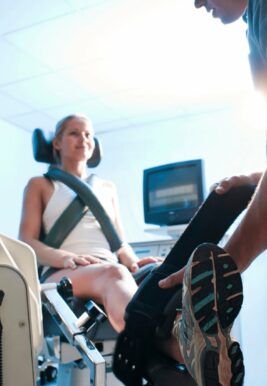Learn
Drop Jump Test | Dynamic Knee Valgus | Post ACL Surgery Test
A deficiency in the neuromuscular control of the hip has been identified as a key risk factor for noncontact anterior cruciate ligament injury. This deficiency can manifest itself as a valgus knee alignment during tasks involving hip and knee flexion. The Drop jump test is a test to observe and evaluate the dynamic knee valgus. It helps clinicians decide whether patients have a low-risk of high-risk landing mechanism.
Kappa coefficients for intra-rater and inter-rater agreement ranged from 0.75 – 0.85, indicating that ratings were reasonably consistent over time and between physiotherapists. Sensitivity and specificity values were inadequate, ranging from respectively 67% – 87% and 60% – 72%. To detect a greater proportion of individuals at risk of ACL injury, clinicians should ensure that they include additional tests for other high-risk characteristics in their screening protocols.
To conduct the test, let your patient stand on a 31cm high box. Then the patient drops down to the floor and immediately performs a maximum vertical jump. The patient needs to keep his or her arms in the “stop position”. The shoulders should be abducted at 45° and the elbows flexed at 90°, to reduce momentum from the arm swing. To minimize learning effects, 3 practice trials of the drop-jump are allowed. After this, 9 consecutive drop-jump trials were conducted. A ten-second rest between trials is allowed to reduce fatigue.
To observe the test, it’s easiest to film the patient with a camera. An easy tool you can use is the app called “Huddle”. You can film the patient and watch the video back in slow-motion. After observing the performance, the clinician decides whether the performance was a high-risk or a low-risk.
A low-risk landing mechanism is a landing where the patella has remained in line with the first toe. A high-risk landing mechanism is a landing where the patella has moved inward and ended up medial to the first toe. Be aware, however, that it is as yet unknown exactly how much dynamic knee valgus may predispose an individual to future injury. Until this is known, the validity of screening guidelines such as this will remain unclear. Recent literature discusses the fact that unilateral knee valgus could be a potential risk factor as well. People at higher risk shows increased knee valgus and ipsilateral trunk motion. Studies comparing bilateral and unilateral leg drop jumps have shown that the dynamic change in lower limb alignment is greater in the single-leg drop jump compared to bilateral leg drop jump. Considering this information and the fact that the drop jump test isn’t very accurate in screening athletes, we think that unilateral hop tests can be useful as well in the rehab- and return to sport process. You can see the video about unilateral hop tests right next to me.
LEARN TO OPTIMIZE REHAB & RTS DECISION MAKING AFTER ACL RECONSTRUCTION

Other useful performance tests that you might be interested in are:
References
Like what you’re learning?
BUY THE FULL PHYSIOTUTORS ASSESSMENT BOOK
- 600+ Pages e-Book
- Interactive Content (Direct Video Demonstration, PubMed articles)
- Statistical Values for all Special Tests from the latest research
- Available in 🇬🇧 🇩🇪 🇫🇷 🇪🇸 🇮🇹 🇵🇹 🇹🇷
- And much more!








